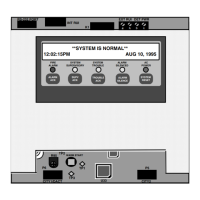2-2
During a programming session, the edit changes are stored in a temporary
memory area called the Edit Buffer. This means that you can leave the
programming session and perform other operations on the 4005.
As a result of this flexibility, the edit session becomes a two-step operation:
1. Editing and
2. Saving the changes to CFIG.
After the edit session is complete, you must select the “Save to CFIG” option in
order to save the edit changes (see the Save to CFIG in Chapter 6 of this
publication). There are two programming reminder screens that notify you to act
on changes in the Edit Buffer. Additionally, if there are no key presses within 10
minutes, the system returns to the High-Level Status screen at access level 1.
During programming mode, only certain keys remain active. When in the
programming mode, the 4005 still functions as a fire alarm system. If an alarm
should sound, use the <Exit/Clear> key to exit the programming mode (by
pressing the key several times). Once at the High-Level Status Screen (the
display shows the first alarm or a normal status) alarms, supervisories, or
troubles can be acknowledged and/or viewed for additional information.
Figure 2-2 illustrates the front panel of the 4005 with a High-Level Status screen
displaying normal system operation.
Refer to the 4005 Fire Alarm
Installation/Operating Instructions (Pub. No.
FA4-21-650) for more information on the operator keys.
Figure 2-2. 4005 Front Panel
Continued on next page
Basic Things to Know About Programming a 4005
Storing and Saving Editing
Changes
Programming Keys
6<67(0,61250$/
P
0RQ$XJ
FIRE
ALARM
SYSTEM
SUPERVISORY
SYSTEM
TROUBLE
ALARM
SILENCED
AC
POWER
ALARM
ACK
SUPV
ACK
TROUBLE
ACK
ALARM
SILENCE
SYSTEM
RESET
Menu Function
Disable
Enable
Exit
Clear
Enter
Previous
Next
LCD
LEDs
Operator Keys
Menu Navigation Keys
(Become Programming
Keys in Programming
Mode)
Technical Manuals Online! - http://www.tech-man.com

